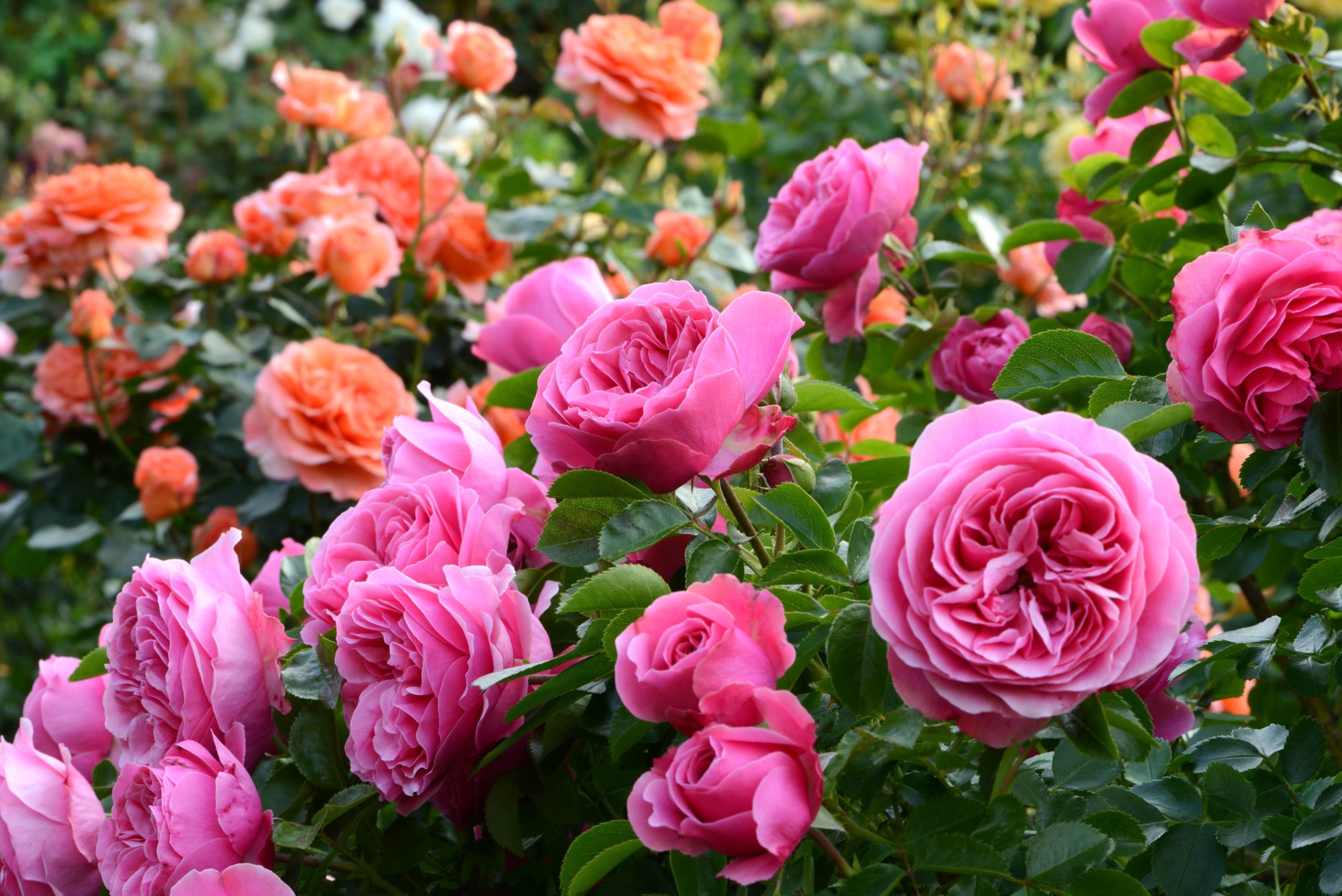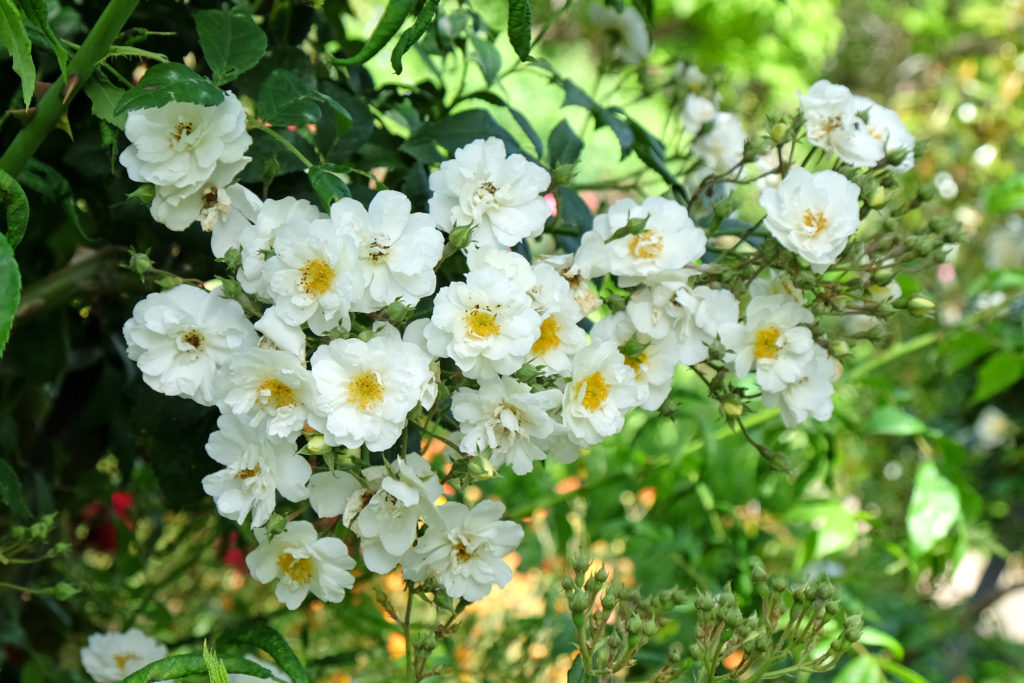Roses are among the most versatile plants and can be incorporated into a wide range of garden styles, from the relaxed charm of a cottage garden to the sleek sophistication of a modern minimalist landscape. By carefully selecting the right rose varieties and complementing them with suitable companion plants, you can create a garden that is both visually stunning and harmonious. Below is a detailed exploration of different garden styles that are well suited to growing roses, including recommended rose varieties and plants to enhance each setting.
Cottage Garden
A cottage garden is an informal and abundant planting style that evokes the charm of old English country gardens. It is characterised by a riot of colour, densely planted flower beds, and a mix of traditional plants that spill over pathways and weave together effortlessly. Roses are at the heart of a cottage garden, adding to its romantic and whimsical feel with their soft, billowing blooms and strong fragrance.
For a true cottage garden effect, it is important to choose old-fashioned and English shrub roses with a full, blousy appearance. Varieties such as ‘Gertrude Jekyll’ and ‘The Generous Gardener’ are ideal, offering classic forms and strong, old-rose scents. The deep crimson ‘Munstead Wood’ provides a striking contrast against pastel blooms, while the delicate pink ‘Cécile Brunner’ works well as a climbing variety to drape over trellises and arches. Compact, spreading roses such as ‘The Fairy’ are perfect for edging paths and filling gaps.
Companion planting is essential to achieving the relaxed and overflowing aesthetic of a cottage garden. Lavender, with its silvery foliage and fragrant purple flowers, pairs beautifully with roses while attracting pollinators. Tall, spired plants such as foxgloves and delphiniums add height and create a layered effect, while hardy geraniums and catmint weave through borders, softening the edges of planting beds. Clematis is an excellent partner for climbing roses, creating a stunning combination of intertwined blooms over fences and archways.
Formal Garden
A formal garden is defined by structure, symmetry, and carefully planned planting schemes. This style is often inspired by classical European gardens, where neatly clipped hedges, geometric flower beds, and elegant pathways create a sense of order and refinement. Roses play a central role in formal gardens, with their symmetrical blooms and structured growth habits lending themselves perfectly to regimented planting designs.
Hybrid tea roses and floribunda roses are particularly well suited to this style, as their upright growth habit and perfectly formed flowers maintain the neat and orderly appearance of a formal garden. ‘Queen Elizabeth’ is an excellent choice for structured beds, with its tall, stately growth and soft pink flowers. The ever-popular ‘Iceberg’ provides crisp white blooms that contrast beautifully against deep green hedging. ‘Boscobel’ and ‘Chandos Beauty’ offer salmon-pink and ivory-pink tones, adding a soft elegance to the landscape, while the lavender-hued ‘Blue Moon’ creates an unexpected but sophisticated accent.
To enhance the structured look of a formal garden, roses are often framed by low hedges of boxwood or yew, which provide year-round greenery and define the layout. Architectural plants such as alliums, with their tall, spherical blooms, add vertical interest and reinforce the geometric nature of the design. Salvias and veronicas create a contrast with their spiky flower forms, while tulips add an early-season burst of colour before the roses begin to bloom.
Wildlife Garden
A wildlife-friendly garden is designed to attract and support birds, bees, butterflies, and beneficial insects by providing nectar, pollen, and shelter. Roses can play a crucial role in this type of garden, particularly varieties with open, single or semi-double flowers that allow easy access to pollen for bees and other pollinators. The presence of rose hips in autumn also provides a valuable food source for birds.
Species roses and wild roses, such as ‘Rosa Rugosa’ and ‘Canary Bird,’ are excellent choices for a wildlife garden, as they are naturally disease-resistant and produce an abundance of nectar-rich flowers followed by colourful hips. Shrub roses like ‘Kew Gardens’ and ‘Ballerina’ bloom repeatedly throughout the season, ensuring a continuous supply of food for pollinators. Rambling roses, including ‘Rambling Rector,’ can be trained over fences and pergolas, creating a natural-looking habitat that blends seamlessly into the garden.
Companion planting is key to encouraging biodiversity in a wildlife garden. Buddleia, often called the butterfly bush, attracts a wide range of pollinators, while echinacea and verbena provide late-season nectar sources. Wildflowers such as ox-eye daisies, cornflowers, and poppies contribute to the naturalistic feel of the garden while supporting a thriving insect population. Planting hedgerow species such as hawthorn and elderberry alongside roses further enhances the habitat for birds and small mammals.
Mediterranean Garden
A Mediterranean-style garden is inspired by the sun-drenched landscapes of Southern Europe and features a relaxed, drought-tolerant planting scheme. The colour palette of this style is often warm and vibrant, with golden yellows, rich oranges, and deep reds dominating the landscape. Roses can thrive in this environment if the right varieties are chosen, particularly those that are heat-tolerant and capable of flourishing in well-drained soil.
Warm-toned roses such as ‘Lady of Shalott’ and ‘Teasing Georgia’ blend beautifully with the sun-bleached stone and terracotta elements typical of Mediterranean gardens. The russet-orange ‘Hot Cocoa’ provides a striking focal point, while the creamy-white ‘Sally Holmes’ adds a softer, more relaxed feel. Compact roses like ‘Molineux’ perform well in this setting, offering repeated flushes of yellow blooms that glow in the sunlight.
Drought-resistant companion plants such as rosemary, santolina, and euphorbia help to create a low-maintenance and visually interesting landscape. Agapanthus, with its striking blue flowers, creates a stunning contrast against the warm hues of the roses, while lavender and artemisia contribute silvery foliage that enhances the Mediterranean aesthetic.
Modern Minimalist Garden
A modern minimalist garden is defined by clean lines, a restrained colour palette, and a focus on structure and simplicity. This style often incorporates hard landscaping elements such as gravel, concrete, and sleek wooden decking, with planting kept to a carefully curated selection of species. Roses can be used as statement plants in this setting, either in neat rows or as striking focal points within a structured design.
Monochromatic roses such as ‘White Drift’ and ‘Carte Blanche’ reinforce the sleek aesthetic of a modern garden, while the deep red ‘Black Baccara’ adds a touch of drama. The unique purple-blue hue of ‘Rhapsody in Blue’ provides a bold contrast against neutral backgrounds, making it an excellent choice for contemporary landscapes.
To complement the clean design of a modern garden, companion plants should be selected for their architectural form rather than their colour or abundance. Ornamental grasses such as Miscanthus and Stipa tenuissima provide movement and softness, while structural plants such as phormium and yucca add strong, sculptural lines. Dark-leaved Heuchera varieties can be planted at the base of roses to provide an additional layer of contrast and depth.
Woodland Garden
A woodland garden is a natural, shaded space that embraces a layered planting style to create a secluded and tranquil retreat. While roses generally prefer full sun, there are a number of varieties that thrive in dappled shade, making them suitable for woodland settings.
Shade-tolerant roses such as ‘Madame Alfred Carrière’ and ‘Blush Noisette’ work beautifully in these conditions, producing delicate blooms that add softness to the landscape. The apricot tones of ‘Ghislaine de Féligonde’ provide a gentle contrast against the greenery, while the deep pink blooms of ‘Wild Edric’ introduce a richer, more dramatic element.
Woodland gardens benefit from companion plants that thrive in partial shade, such as ferns, foxgloves, and astrantia. Hellebores add early-season interest with their nodding flowers, while hardy geraniums provide ground cover and help to integrate roses into the naturalistic setting.


